The busiest US-Canada border crossing reopened last Sunday
Web Desk Updated: February 15, 2022
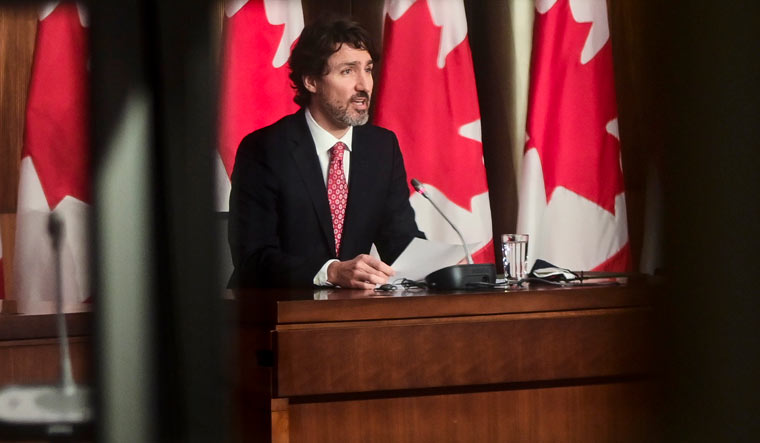
Canadian Prime Minister Justin Trudeau invoked the Emergencies Act for the first time in 50 years, to quell the trucker protests in the country against coronavirus mandates. Earlier, the police had arrested 11 people with a "cache of firearms" blocking a border crossing with the United States. As news agency AFP reported, Trudeau said the military would not be deployed at this stage, but authorities would be granted more powers to arrest protesters and seize their trucks in order to clear blockades, as well as ban funding of the protests.
Thousands of protesters railing against vaccine mandates and other COVID-19 restrictions descended on the capital Ottawa last month, deliberately blocking traffic around Parliament Hill.
Trudeau said one must be “very, very cautious” about deploying troops on Canadian soil, adding there has been no such request to the federal government. He said any formal requests for assistance from the City of Ottawa or Ontario will be considered. Organisers had raised millions for the cross-country “freedom truck convoy” against vaccine mandates and other restrictions.
It has attracted support from former US President Donald Trump. Ottawa's mayor, meanwhile, is calling on several opposition Conservative lawmakers to apologize for praising the protesters and posing with them. A photo posted by one of the lawmakers shows them some giving the thumbs-up—in front of one of the protest trucks, which have been barricading roads and honking horns in the city almost non-stop.
The busiest US-Canada border crossing reopened last Sunday after protests against COVID-19 restrictions closed it for almost a week, the owner announced. The bridge's owner, Detroit International Bridge Co., said in a statement that the Ambassador Bridge is now fully open allowing the free flow of commerce between the Canada and US economies once again.
Police in Windsor, Ontario, said earlier that more than two dozen people were peacefully arrested, seven vehicles were towed and five were seized near the bridge that links the city and numerous Canadian automotive plants with Detroit.
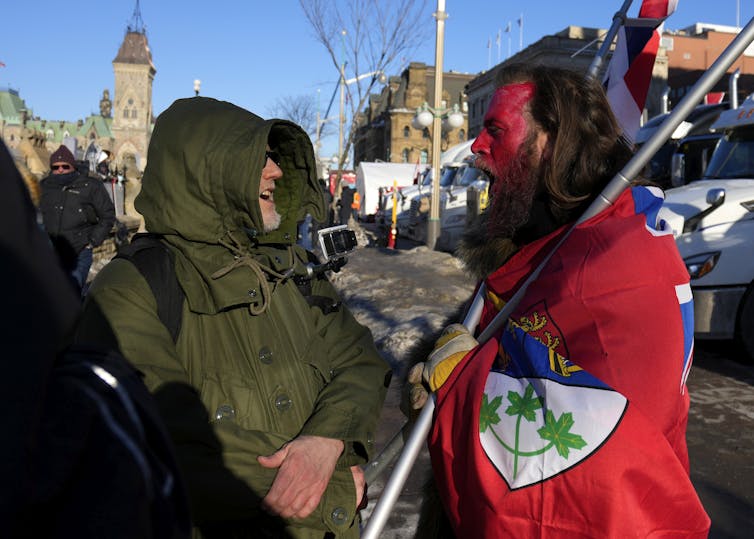
Canadian Prime Minister Justin Trudeau has invoked the Emergencies Act in an effort to quell the protests by truckers and other groups opposed to measures aimed at preventing the spread of COVID-19. The federal government has never before acted to implement this once-obscure piece of disaster and emergency legislation.
Trudeau has suggested the additional tools the Emergencies Act provides for will allow the federal government to manage situations as they emerge, take extraordinary actions that are time-limited, have specific geographic bounds and deploy a measured use of out-of-the-ordinary expansive governmental powers.
“This is about keeping Canadians safe, protecting people’s jobs and restoring confidence in our institutions,” Trudeau said in a national address Monday.
Canada is still in the midst of the COVID-19 global pandemic emergency. At the time of Trudeau’s announcement, 35,470 Canadians had died of COVID-19 since the beginning of the pandemic.
Prime Minister Justin Trudeau responds to reporters’ questions after invoking the Emergencies Act in response to the so-called freedom convoy’s ongoing occupation of Ottawa.
The Emergencies Act of 1988 is part of the Revised Statues of Canada. Such legislation is reserved for use under the most extreme emergencies or existential threats. In more than 30 years, no Canadian government has determined that any disaster — natural or man-made — has created such a grave threat to the nation.
The act’s legislation names examples of emergencies that may rise to the level of top concern. Public welfare emergencies are what most people would consider as disasters, including natural phenomena and man-made catastrophes. Public order emergencies consist of various threats from civil disorder — the current occupation of Ottawa being an example. In addition, aspects of international emergencies and warfare can be addressed within the context of the Emergencies Act.
The legislation means that additional extraordinary government powers can be applied to manage an extreme emergency. These include additional layers of security for specific locations and critical infrastructure, people can be compelled to render essential services with compensation and the RCMP — Canada’s national police force — can be used to enforce municipal laws.
In the case of the current protests in Ottawa and other parts of the country, an additional new and significant aspect affects the financial support mechanisms for the ‘freedom convoy’ occupation. The methods and instruments of such financial support will now come under closer security in accordance with a broadening of Canada’s anti-terrorism financing rules.
War Measures Act
The shadow of history is important here as Trudeau stresses he is not using the invocation of the Emergencies Act to call the Canadian military onto the streets to confront citizens.
It’s an essential point for him to make: in 1970, Trudeau’s father, Pierre, invoked the War Measures Act in one of the most controversial decisions of his 15-year tenure as prime minister. The older Trudeau brought the military into the streets during the October Crisis after a series of terrorist attacks perpetrated by the separatist group known as the Front de libération du Québec.
The War Measures Act dates back to 1914. It was intended to give the Canadian government extra powers during times of war, invasion and insurrection. Due to real and perceived injustices related to use of the act, it was repealed in the 1980s. One of those injustices was that the War Measures Act facilitated the internment of nearly 22,000 Japanese Canadians living in British Columbia during the Second World War.
Read more: Coronavirus: Racism and the long-term impacts of emergency measures in Canada
When the Emergencies Act succeeded the War Measures Act in 1988, it introduced changes regarding how the federal government can use extraordinary powers in times of crisis. Those changes include forcing cabinet to seek Parliament’s approval for new emergency laws, and requiring any emergency actions to take place in a manner consistent with the provisions of the Canadian Charter of Rights and Freedoms.
The Charter is the most recognized part of Canada’s Constitution. It guarantees the rights of individuals by enshrining those rights, and puts certain limits on them.
Trudeau stressed that by using the Emergencies Act, the government was “not suspending fundamental rights or overriding the Charter of Rights and Freedoms. We are not limiting people’s freedom of speech. We are not limiting freedom of peaceful assembly. We are not preventing people from exercising their right to protest legally. We are reinforcing the principles, values and institutions that keep all Canadians free.”
In the coming days, Parliament will begin an unprecedented process of legislatively enacting emergency powers. It is not guaranteed that Parliament will concur with all of the provisions of the implementation of the Emergencies Act as tabled by the Trudeau administration.
A confrontation between a ‘freedom convoy’ protester yelling ‘freedom’ and a person opposed to the occupation. THE CANADIAN PRESS/Justin Tang
All disasters are political
The historic invocation of the Emergencies Act — due to the actions of a small group of people — begs the question: what comes next?
First, we will see numerous parliamentary procedures in Ottawa starting immediately with the specific details of what the implementation of the Emergencies Act will actually mean.
Second — perhaps more importantly to those in Ottawa and elsewhere whose lives are being negatively impacted by the continued disruptions — the act will swiftly allow for action to bring the immediate crisis to an end.
There will be changes in how people will be allowed to gather. There will also be designations of new zones with enhanced security protocols at locations with critical infrastructure, government operations, border crossings and airports.
Additional services will be provided to spots under occupation, such as downtown Ottawa. Specifically, services such as heavy towing could be brought to bear on the situation in ways not available before.
Third, the invocation of the Emergencies Act sends out the symbolic message that Canada is treating the current anti-mandate blockages and occupations with the utmost seriousness. As Ottawa approaches the third week of the occupation, this action should have taken place much earlier.
In the end, all disasters are political. There will be an examination of why it took so long to invoke the Emergencies Act. But in the meantime, Canada is telegraphing to the world that public order will be maintained — and the government can take action to quell this crisis of social origin.
Author
Associate Professor of Disaster and Emergency Management, York University, Canada
Disclosure statement
Jack L. Rozdilsky is a Professor at York University who receives funding from the Canadian Institutes of Health Research as a co-investigator on a project supported under operating grant Canadian 2019 Novel Coronavirus (COVID-19) Rapid Research Funding.
Sean Hannity says if Canadian truckers are arrested he “can’t guarantee that at that point people won’t defend themselves”
WRITTEN BY MEDIA MATTERS STAFF
PUBLISHED 02/14/22
EZRA LEVANT (GUEST): There is no revolution in the streets of Canada. You see for yourself, it's a festival environment. There's no violence. It's happy -- moms and dads and kids. Trudeau is claiming they're dangerous, claiming they're terrorists so he can seize bank accounts. The most scary thing announced today by the finance minister, who was on the World Economic Forum board, is that banks will be directed to seize your accounts without due process and you can't even sue them. They're indemnified. He is going after his political opponents to seize their resources Venezuela style.
SEAN HANNITY (HOST): I've got to tell you, I never thought I'd see it in Canada, but I see that the truckers are winning. I think these five provinces, it's a significant win. And if -- I mean, if he wasn't going to this extreme, the truckers have been peaceful. If this turns into something else because he's sending people in there directly to confront them, I can't guarantee that at that point people won't defend themselves. Is Trudeau that stupid? He looks -- he doesn't seem that bright to me.
OTTAWA—Freedom Convoy organizers say they will continue to protest on Parliament Hill despite the federal government’s declaration of a state of emergency.
“We are not afraid. In fact, every time the government decides to further suspend our civil liberties, our resolve strengthens and the importance of our mission becomes clearer,” organizer Tamara Lich said on Feb. 14 in anticipation of Prime Minister Justin Trudeau invoking the Emergencies Act over the protests demanding an end to COVID-19 mandates.
“We will remain peaceful, but planted on Parliament Hill until the mandates are decisively ended. We recognize that there is a democratic process within which change occurs. We have never stepped outside of that process, nor do we intend to.”
Trudeau is the first prime minister to use the Emergencies Act. The act replaces the War Measures Act, which was last used by Trudeau’s father, then-prime minister Pierre Trudeau, in 1970 during the October Crisis when Quebec separatists kidnapped and killed Quebec cabinet minister Pierre Laporte.
The act gives the state additional powers to deal with the protests and blockades, such as providing legal tools to cut funding to protesters, as well as freezing the corporate accounts of companies whose trucks are used in any blockades and removing their insurance.
The province of Ontario and the city of Ottawa have also declared states of emergency over the protests.
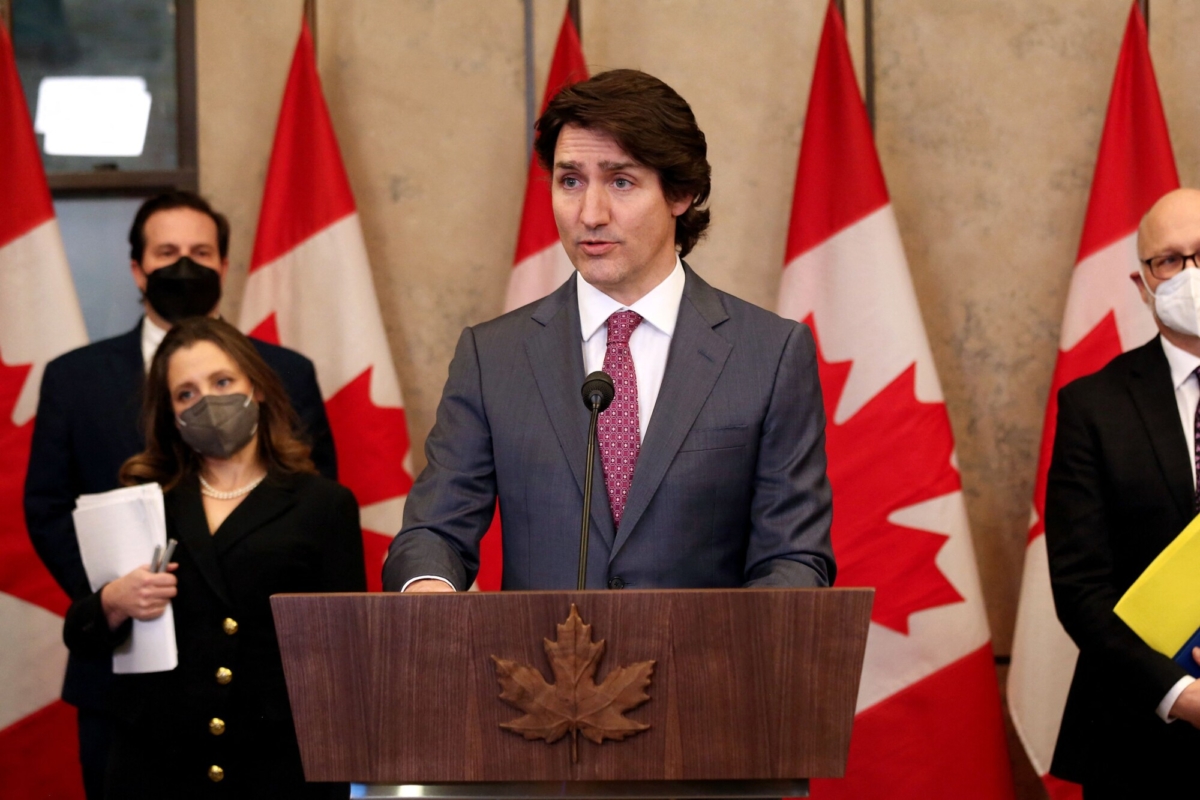
The protests were initiated by truck drivers opposed to COVID-19 vaccination mandates for cross-border travel. As convoys of truckers made their to Ottawa, many supporters joined the movement, which turned into a large-scale protest against all COVID-19 mandates and restrictions. Many protesters who converged into Ottawa on Jan. 29 say they intend to stay in the capital until COVID-19 mandates are lifted.
Separately, protest convoys set up blockades at border crossings in Ontario, Alberta, Manitoba, and British Columbia. The blockade at the Ambassador Bridge connecting Windsor to Detroit, which accounts for hundreds of millions of dollars in trade between Canada and the United States, was cleared over the weekend.
“The Emergencies Act will be used to strengthen and support law enforcement agencies at all levels across the country. This is about keeping Canadians safe, protecting people’s jobs, and restoring confidence in our institutions,” Trudeau said.
“The police will be given more tools to restore order in places where public assemblies can constitute illegal and dangerous activities such as blockades and occupations as seen in Ottawa, Ambassador Bridge, and elsewhere.”
Lich said Canadians “should be surprised” that such “an extreme measure” is being used against peaceful protesters.
“We have countless vulnerable people in our crowd, including children, the elderly, and the disabled, who cannot be met with force by a genuine liberal democracy. The right to peaceful protest is sacrosanct to our nation. If that principle is abandoned, the government will reveal itself as a true tyranny and it will lose all of
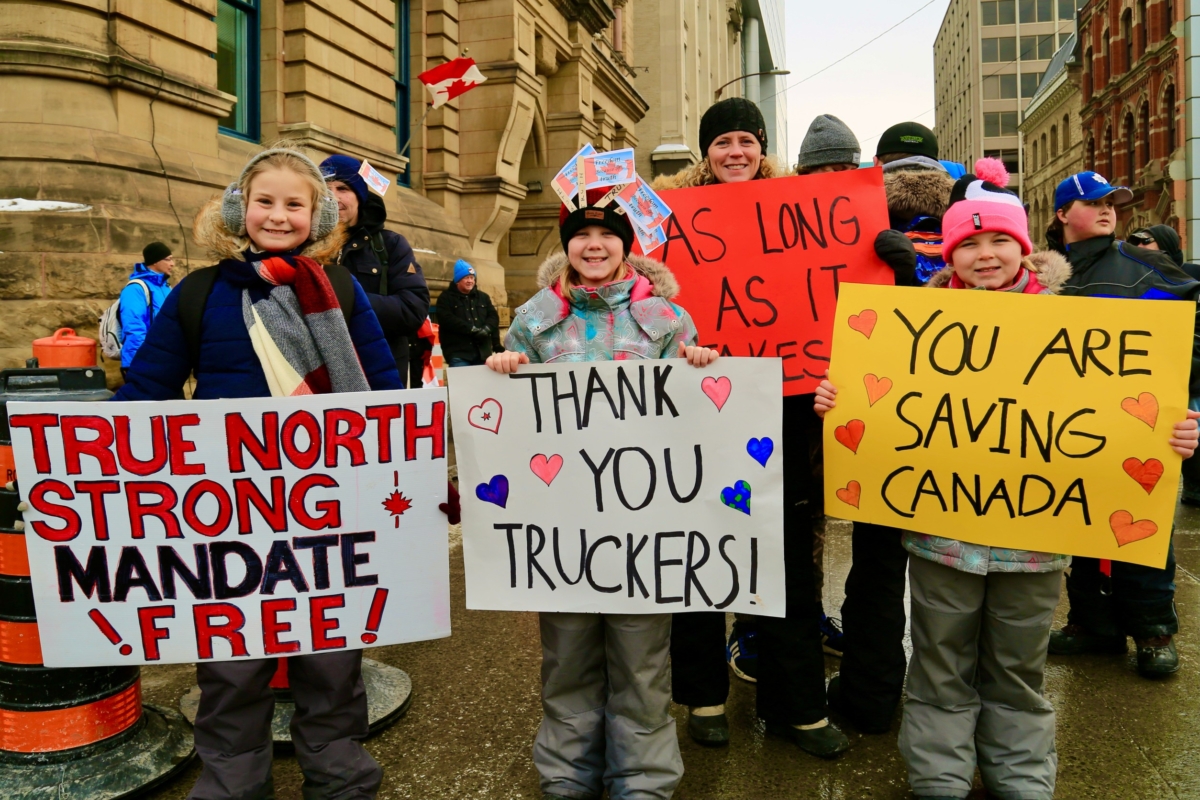
its credibility,” she said.
Lich said she realizes some people are opposed to the protests, but noted that a democratic society “will always have non-trivial disagreements and righteous dissidents.”
“There are many reasons for us opposing the mandates,” she said. “Some of us have been mistreated by our government, including many of our indigenous communities, who have personally experienced medical malpractice. Some of us simply want bodily autonomy and oppose the mandates on principled grounds. No matter our reasons and opinions, it is how the government responds to its citizens that determines the fate of the country.”
Addressing the prime minister, Lich said, “No matter what you do, we will hold the line.”
“There are no threats that will frighten us.”
Brian Peckford, former premier of Newfoundland who is acting as a spokesperson for the Freedom Convoy, said this is “a very, very strange moment in our history.”
“This is again government overreach. We don’t do these kinds of things in Canada. We engage in dialogue,” Peckford said.
“It’s my understanding that the government of Canada has not reached out once to the truckers since they have arrived in this capital city. I find that very hard to understand, because how can you justify going to a measure like an emergency, measures where a lot of powers can be imposed upon the citizens, when you have not even yourself taken any action to engage.”
Inside The Nerve Center That Keeps The Ottawa Trucker Protests Running
What do they eat, where do they go to the bathroom, how did they get functioning saunas, and other questions answered.
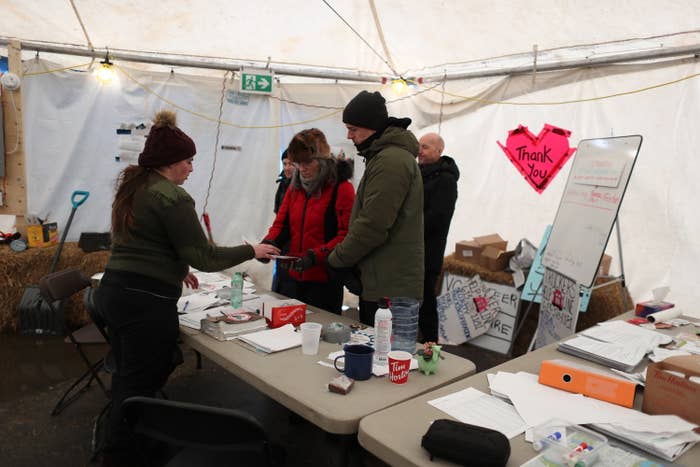
Inside one of the organizing tents at the so-called Freedom Convoy.
OTTAWA — When Ottawa police let hundreds of protest vehicles drive into the downtown core of the nation's capital they did so under the seemingly reasonable assumption that there was no way the demonstrators could stick around in the streets of a city where temperatures regularly dip below 0 degrees Fahrenheit.
The police were wrong. Backed by donations of cash and supplies, the anti-vaccine mandate protesters have created an off-book supply chain to keep hundreds or thousands of people clothed and fed indefinitely.
They do this with the help of a separate site — a parking lot full of vehicles and tents — that serves as a sort of supply depot and logistics center. Staged next to a baseball park on Coventry Road, a few miles east of downtown, it is essentially sanctioned by the city. Police have abandoned hopes of removing protesters for now and are adopting a strategy of containing and keeping watch.
That is not to say that police have left it entirely alone. Earlier this month, dozens of armed officers executed a nighttime raid on the site, seizing a cache of fuel.
While the vibe downtown feels akin to a Canada Day festival, the Coventry Road site has more of a quasi-military feel. Journalists are, generally, not welcome. There have been no reports of violence, but intense-looking guys staring down reporters sends the message.
“I got the distinct impression that it would be way, way better for me to be somewhere else. I left,” Matt Gurney wrote in the Line
One of the first things photographer David Kawai and I saw on Saturday afternoon when we arrived at the site was a white van with “FREDOM” taped on the side. It wasn’t a typo. The owner of the van said he just ran out of tape.
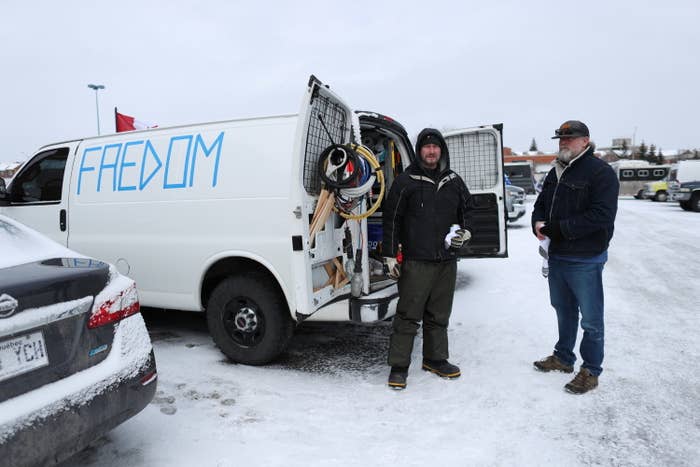
Scenes from third weekend of the so-called “Freedom Convoy” in Ottawa, Ontario, Canada, on Saturday, Feb. 12, 2022.
When I approached the registration tent — there is a registration tent — a man who lived nearby said his 16-year-old son wanted to come and volunteer. “He’s a strong boy, he can lift stuff for you,” the man said. “The only thing is, he can’t drive.”
I identified myself as a reporter with BuzzFeed News. This kicked off a tense and confused few minutes where several people surrounded me, saying they needed to determine if I was good media or bad media. One woman demanded I prove I was who I said I was. It wasn’t clear who was actually making the final call, but eventually one man stood up for us. We were allowed to enter.
The first tent we went into felt like an administrative area, complete with tables, chairs, supplies, and whiteboards listing names and numbers of key contacts. Another whiteboard listed French and English directions ranging from handling fuel to dealing with police (“Stay calm/Restez calme,” “Right to remain silent/Vous avez le droit de garder le silence.”) Signs with slogans like “Natural immunity is God’s science” sat in the corner.
Scenes from third weekend of the so-called “Freedom Convoy” in Ottawa, Ontario, Canada, on Saturday, Feb. 12, 2022.
After a bit more haggling over access, we were allowed to enter the main tent. It felt like entering a small supermarket. Tables overflowed with supplies. Fresh produce, canned goods, soap, winter clothing, you name it, it was on offer. Dozens of people were buzzing about. Some were working, some were sitting and enjoying a meal.
“This is just a place for people to come and warm up, eat,” said Carlo, an organizer from Montreal who didn't want to give his last name. “It’s very heartwarming. It’s shocking, actually, to see the amount of support that we get.”
Carlo said all of the supplies were donated. Volunteers transport them downtown as needed, or protesters can come out to Coventry Road for a meal.
Taped to the exit of the main tent is a photo of a young girl holding a sign saying “The truckers are coming to save us.” One of our guides paused to point it out, saying, “This Is What We Do It All For
The operation feels both surprisingly organized and ad hoc. At a couple points, a man walked up to us to ask what we were doing and who authorized us to be there. My answer didn’t seem particularly convincing. I said I had been told to call a man named David, who after some discussion gave me permission over the phone to walk around. But no one seemed to know what the proper protocol for handling media was, if one even existed, and no one kicked us out. The longer we hung around, the more the organizers warmed up to us.
Carlo took us to an unexpected feature of the camp: two fully functional saunas. He said a guy came and dropped them off out of the blue, telling organizers to use them as long as they want and to give him a call when they’re done with them. Same story for the mobile bathroom unit.
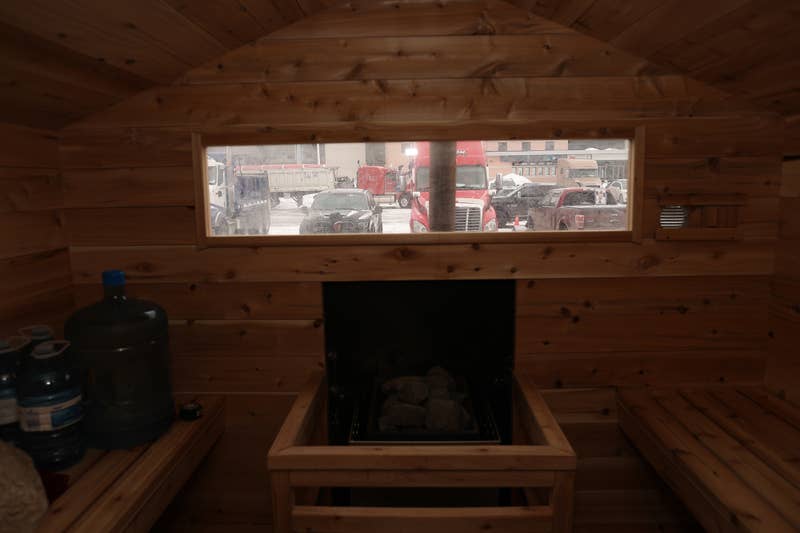
A sauna that was donated for use at the so-called Freedom Convoy
“Companies are just pouring in and installing stuff for us, whether it’s mobile bathrooms, kitchen equipment, tents. Everything you see here was donated,” he said.
There was no visible sign of police. Carlo said it’s clear the police don’t want the camp there and they’ve come a couple times — most notably during the fuel raid — but for the most part have left the camp alone.The people there are, understandably, proud of how much support they’ve received. Through these donations, they’ve created a supply chain that has kept the downtown protests going strong for over two weeks now
“We’re here for as long as it takes,” Carlo said. “We came here already equipped — and with the support we’ve been getting, I think we’re more than equipped right now to be here for the long term.”
The Coventry Road supply center is not, however, the movement’s headquarters, and protesters spend most of their time downtown. Top organizers are also elsewhere so that, according to one volunteer, police can’t move in and round them up.
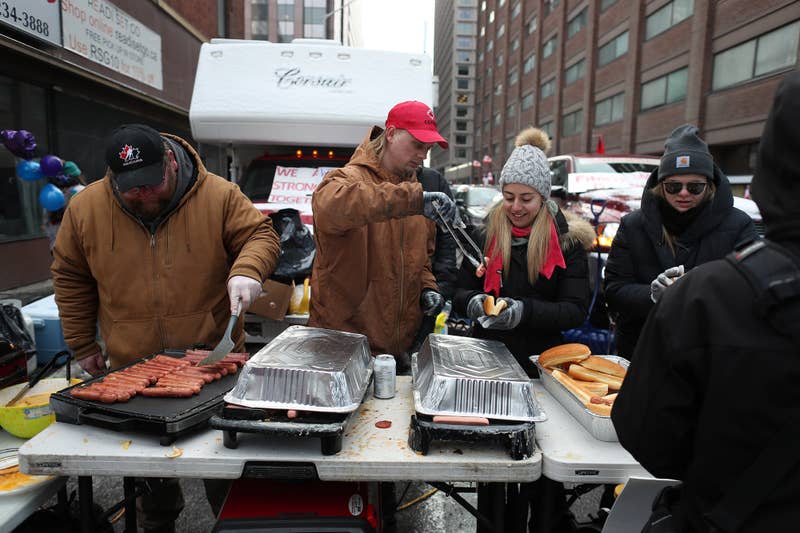
Scenes from third weekend of the so-called “Freedom Convoy” in Ottawa, Ontario, Canada, on Saturday, Feb. 12, 2022.
The supply chain manifests in soup kitchens and hot dog stands on street corners downtown, with volunteers doling out free food and drinks to anyone who wants some. The size of the demonstrations notably spike on weekends, when people drive in from hours away to take part. During the week, people sleep in their cars and trucks.
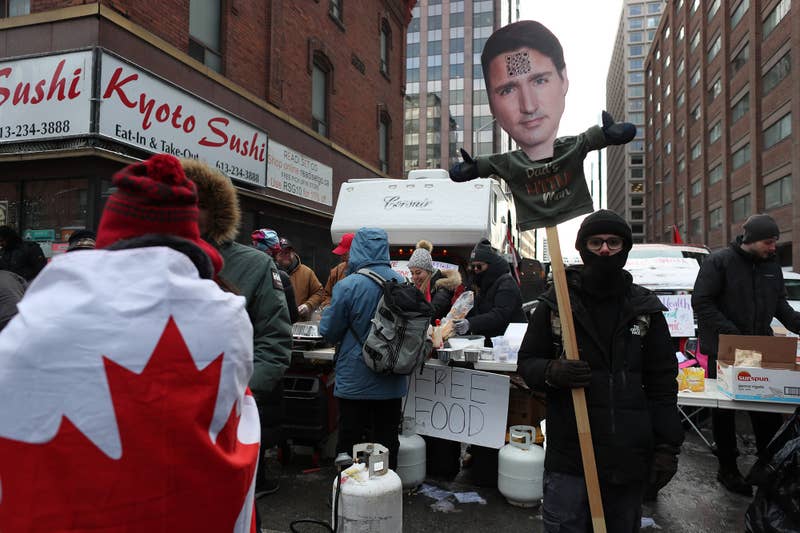
Scenes from third weekend of the so-called “Freedom Convoy” in Ottawa, Ontario, Canada, on Saturday, Feb. 12, 2022.
One question multiple people have asked is: Where do they go to the bathroom?
There are some lines of porta-potties set up throughout the downtown core, but not nearly enough. I asked Greg, a protester who has been living out of a van on Kent Street for over two weeks, where he relieves himself. He said a lot of the local restaurants, cafés, and hotels have let protesters come in and use their bathrooms.
This is a bit of a sore spot for residents. Last month, one Ottawa resident compiled a crowdsourced, unverified list of businesses “supporting” the convoy, which spread around Instagram and Twitter. People and businesses strenuously denied the list was accurate. Convoy supporters picked up on the witch hunt vibe of the list and spread it as evidence of the intolerance from the left
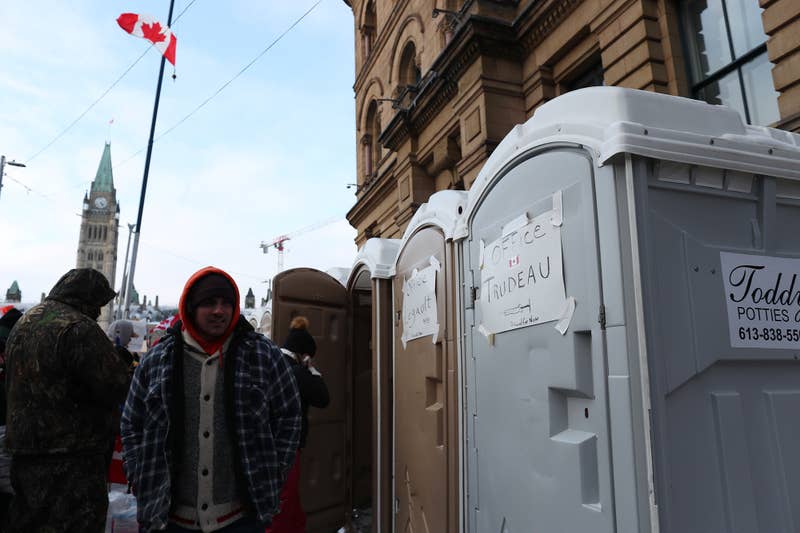
Scenes from third weekend of the so-called “Freedom Convoy” in Ottawa, Ontario, Canada, on Saturday, Feb. 12, 2022.
My impression from talking to bar and restaurant workers is that they are having a very trying few weeks. Some definitely are letting protesters use their bathrooms, but not as some sign of tacit support for the cause. I’ve heard that businesses don’t want to anger the protesters and become a target for retaliation. There’s also just a humanitarian element; most Canadians aren’t going to feel good about saying no to someone who badly needs to go to the bathroom.
As for showers, Greg said many residents in the Ottawa area have extended offers for protesters to come to their homes and wash up.

Scenes from third weekend of the so-called “Freedom Convoy” in Ottawa, Ontario, Canada, on Saturday, Feb. 12, 2022. Photographer: David Kawai/Bloomberg
Then there’s the issue of the millions of dollars’ worth of donations. Organizers initially raised around $10 million through GoFundMe before the company shut the page down and returned the donations. The crowdfunding campaign then moved to the Christian website GiveSendGo and raised around $9 million more. The provincial government successfully petitioned the Superior Court of Ontario to freeze those funds. What happens to the money will be an issue for the court to decide.
GoFundMe did pass on about $1 million to protest organizers before the campaign was shut down. It’s not clear where that money has gone.
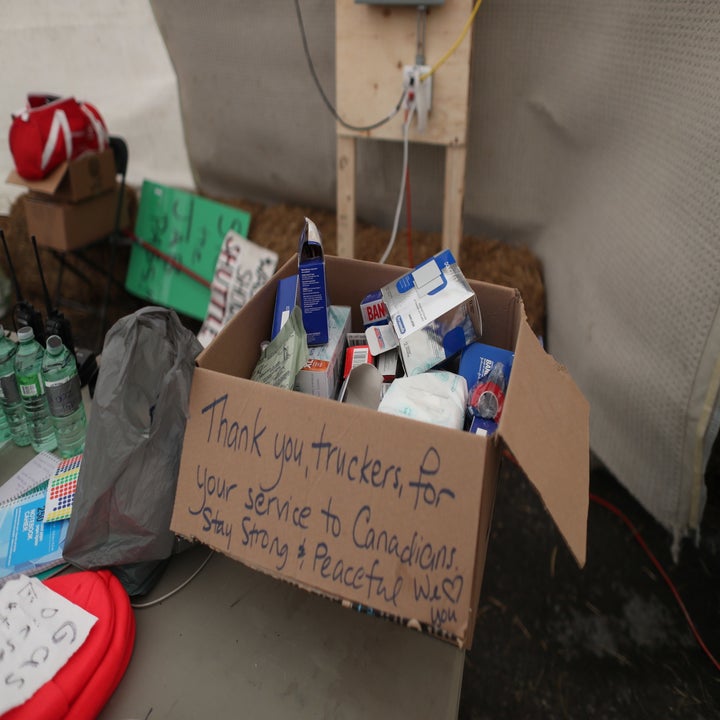
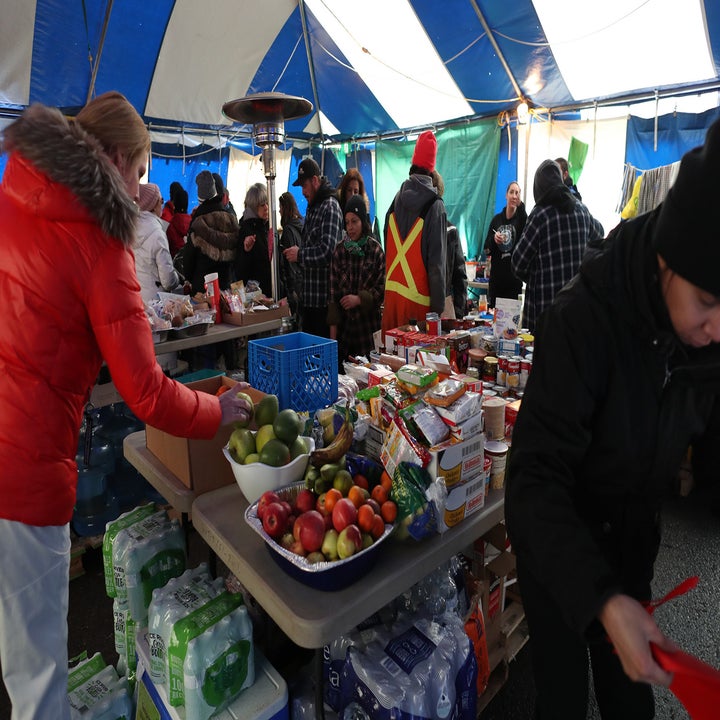
No comments:
Post a Comment